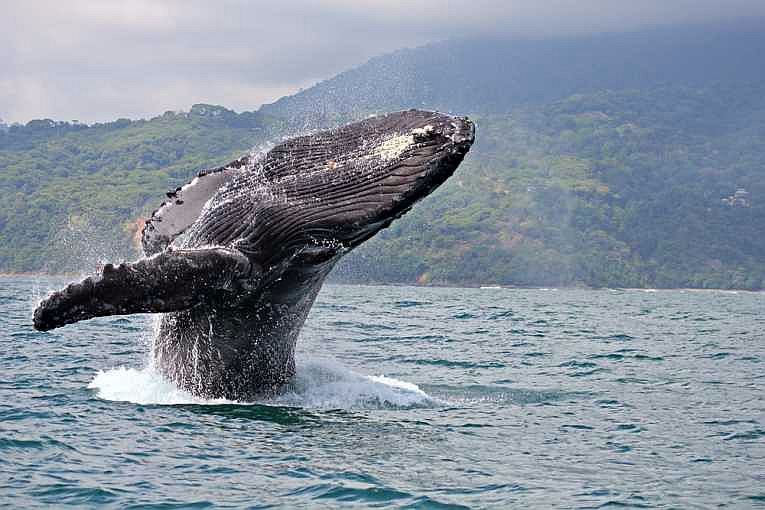The North Atlantic always has enormous shipping activity, and that is increasing. In the western ocean, humpback whales,Megaptera novaeangliae have even been named after the area, but struggle to recover from very low population levels. Success in recovery has often been encouraged by whale-watching and its financial returns for local economies, such as for those who travel to Costa Rica to see this guy - and others.
Looking at 10 tagged individuals who were bottom-foraging, the noise environment to which they were exposed could be assessed. The pollution from noise has been neglected in comparison to the mass of pollution we suffer from other sources. Both marine and terrestrial problems have been noted for many species, including ourselves. The toothed whales (such as dolphins, etc.) have communication and foraging uses for acoustics that are critically affected. Baleen whales like the humpback hunt in coastal areas with lots of shipping, while there have been few responses recorded at the surface by these creatures to loud low-frequency sound. Underwater lies a different set of environmental problems however.
This paper covers research into avoidance behaviours and whether foraging has to be extended when ships pass. The humpback has a bottom side-rolling technique to feed on sand lances (Ammodytes) at night. It is this behaviour that would be particularly when the authors set off to sea in the Stellwagen Bank National Marine Sanctuary in the Gulf of Maine. 7 measurements were taken. Over the course of 218 dives by the 10 whales studied. 83 suffered some ship noise exposure periods.
The 7 measurements were duration, rate of descent and ascent, maximum depth, number of those bottom feeding events, time between dives and surface times immediately following each dive. The ship noises were detectable from Dtag audio recordings, both visually and aurally.
3 metrics were affected in the presence of ship noise. Feeding rolls decreased by 29% and the descent rate was slowed with the whales decreasing speed by 14.5%. The ascent rate also slowed in similar fashion. Adult females, often with calves, were especially likely to dive without feeding normally. The explanation of all this is difficult, as other feeding methods are available to these individual whales, all with different needs and situations.
The threat from shipping may be perceived or they could be habituated to some of the noises. Prey behaviour is highly likely to change too. Sandy sea floors are the retreats for sand lances when disturbed, while the whales themselves could fail to hunt properly if they use paired busts of vocalisations to find their schools of fish. These bursts are of the same low frequency as ship noise, so the effects. would be masked. More habituation could be taking place as the noise emissions in the ocean change with new technologies. Or the whales could simply be unable to adapt to the current noise levels, given their significant levels of reaction shown here!
During daylight hours, traffic is much busier than during these nocturnal recordings. This would be a next step for research, while the obvious reduction in hunting efficiency seen here needs assessment. Do the calves receive sufficient nourishment and can adults themselves feed efficiently at all in this ancestral area? If not, we are dealing with wild species who are unable to sustain themselves as the food webs lose energy from every source. The critically-endangered animals are most obviously at risk and while some whales are recovering generally from over-hunting in the past, many are still at risk. The Atlantic humpbacks seem unique, despite their huge range. Their exposure to normal shipping as well as military naval explosions has been proved to be expensive to their feeding as well as their life style. It is up to us. We need to assess our own irresponsible behaviour as well as that of the species that will in their turn affect our lives in response to their partial of complete loss.
Hannah Blair, Nathan Merchant, Ari Friedlander, David N. Wiley and Susan E. Parks from Syracuse and Oregon State Universities, the Centre for Environment, Fisheries and Aquaculture Science in the UK and Stellwagen Bank National Marine Sanctuary, MA, US presented their paper on Wednesday in the Biology Letters of the Royal Society. They entitle their work Evidence for ship noise impacts on humpback whale foraging behaviour,
but we should pay attention. This noise effect affects much more than the great animals of our waters. It affects marine creatures almost everywhere, and then we have had huge noise problems on land too. We need to be much more vigilant about our sea life, as well as our own doorstep!










